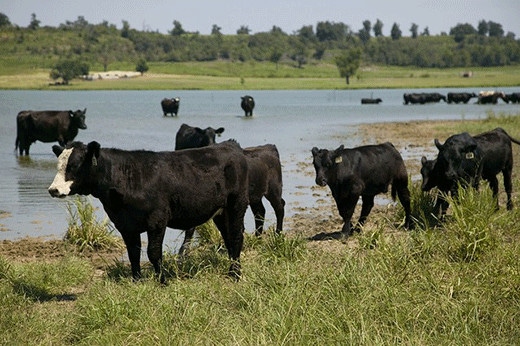Accumulation of factors like humidity, solar radiation, hide color and diet can drastically change ability of cattle to withstand summer heat.
June 29, 2020

Kansas State University veterinarian A.J. Tarpoff is urging cattle producers to beef up their plans for managing heat stress in their herds -- a challenge that costs the U.S. cattle industry up to $370 million in losses each year.
Tarpoff, a beef veterinarian with Kansas State Research & Extension, said cattle are resilient animals and often will acclimate to hot temperatures. However, an accumulation of factors — including humidity, solar radiation, the animal's hide color, diet and more — can drastically change the ability of cattle to withstand summer heat.
“It really is a multi-layer challenge,” Tarpoff said. “Each animal within a group or pen is not affected the same way. Animals with higher body condition scores or with darker hides or finisher steers and heifers that are getting ready to go to harvest are at higher-risk of heat stress.”
Tarpoff said heat stress decreases the reproductive efficiency and performance of cattle grazing on pasture. In confined facilities, heat stress often causes cattle to eat less, which also negatively affects their performance.
The human body cools itself on a hot day by sweating, called evaporative cooling, but Tarpoff noted that cattle sweat only 10% as much as people; instead, panting is their primary way of dissipating heat. “As temperatures rise and their heat load increases, they will start breathing faster,” he said. “They are dissipating heat through tiny droplets in the respiratory tract.”
Doing so, however, causes cows to eat less, setting them on a path to poor growth and future performance.
“This all has to do with heat load,” Tarpoff said. “The internal temperature of cattle will peak two hours after the hottest point of the day. So, our strategy for keeping cows cool needs to be built around knowing that.”
Another factor is that cattle produce heat by digesting food, typically four to six hours after eating. “So, if we feed animals within the wrong period of time, we can actually increase their heat load because the heat of digestion and the heat from the environment are building on top of each other,” Tarpoff said. “We want to keep that from happening.”
Tarpoff listed best management practices for helping reduce heat stress in cows, including:
Handling. Receive, ship or move cattle only during the coolest parts of the day, preferably before 10 a.m.
Feeding. Modify feeding times so that 70% of the animals’ ration is provided as late in the evening as possible. This puts the peak heat of digestion overnight, when temperatures are likely cooler. Decrease the amount fed during the day.
Managing heat. Split cattle between pens, or reduce stocking density. Maximize airflow by removing obstructions around facilities, including weeds. If feasible, install shade structures, which can reduce solar radiation and reduce the temperature on the pen’s floor. Install sprinklers to wet cattle down at night or early morning so as not to increase humidity.
Then, of course, there is the importance of providing water — lots and lots of water, Tarpoff said. “To put it into perspective, when the temperature goes from 70°F to 90°F, cattle will consume about double the amount of water,” he said.
As a rule, cattle should consume “about five times the amount of water as the dry matter they are consuming,” Tarpoff said, adding, “Cool, clean and readily available water is critical during heat stress events. We may have to increase the water tank capacity within a pen to meet these needs. Producers need to be prepared for that.”
Tarpoff said he follows two sources for help with making a decision about when to put a heat stress management plan into full effect.
One source is the U.S. Meat Animal Research Center (MARC), which maintains a seven-day forecast tool for the U.S. that takes into account temperature, humidity and solar radiation.
“The other tool I use is the Kansas Mesonet, which provides an animal comfort index,” he said. The Kansas Mesonet, housed at Kansas State University, is a network of observation towers located across the state that updates climate information every hour. Other states also have Mesonet systems.
“I know that if we don’t have those night-time cooling hours, the animal won’t be starting each day at thermo-neutral, so they’re more at risk on the second or third day,” Tarpoff said. “That’s when we should start putting in some of these management strategies.”
You May Also Like

.png?width=300&auto=webp&quality=80&disable=upscale)

